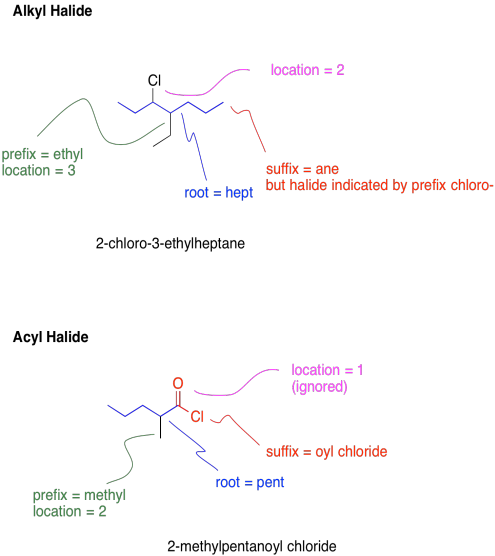
Halogen atoms -- fluorine, chlorine, bromine or iodine -- can be found in organic compounds in a couple of different ways. They may be bonded as a substituent on a hydrocarbon structure, such as an alkyl chain (alkyl halides) or a benzene ring (aryl halides). They may also be attached to a carbonyl carbon (acyl halides or acid halides).
It is useful to know the names of the normal (straight-chain) hydrocarbons, in which straight chains of hydrocarbons are connected by single bonds and the carbons' valences are saturated with hydrogens. The names of these compounds form the root names of other compounds having the same number of carbon atoms in a continuous chain.
| Number of carbons | Name |
| 1 | meth |
| 2 | eth |
| 3 | prop |
| 4 | but |
| 5 | pent |
| 6 | hex |
| 7 | hept |
| 8 | oct |
| 9 | non |
| 10 | dec |
The names of these compounds are based on the names of alkanes, but the suffix of the name varies to indicate the functional group present.
| Class | Icon | Description | Modified prefix | Suffix |
| Alkyl halide | C-X | contains F, Cl, Br or I connected to carbon | halo- (e.g. fluoro-) | ane |
| Acyl halide | CXO | contains a halogen (usually Cl or F) connected to a C=O carbon | - | oyl halide (e.g. oyl chloride) |
Note that, in formal naming, alkyl halides are named as substituents rather than as a main functional group. That is, the suffix of the compound is unchanged by the presence of the halogen, and the halogen is included as a prefix in the name.
In acyl halides, the suffix -oyl chloride is appended to the name. For example, CH3CH2COCl is called propanoyl chloride.

Note that, if more than one of the same type of substituent are present, a prefix is used to tell how many of them are present. For example, CF3CH3 is called 1,1,1-trifluoroethane.
| Number | Prefix |
| 2 | di |
| 3 | tri |
| 4 | tetra |
| 5 | penta |
| 6 | hexa |
| 7 | hepta |
Problem FG5.1.
Draw structures for the following compounds.
a) bromoethane b) 2-chloropentane c) 3-iodononane
d) 2-fluoro-3-methylhexane e) 2,3-dibromoheptane f) 3-chloro-2-fluorodecane
g) 1,1,1-tribromo-2,2-dichloropropane h) 2-fluorobut-1-ene i) (E)-4-iodohex-2-ene
Problem FG5.2.
Draw structures for the following compounds.
a) ethanoyl chloride b) hexanoyl fluoride c) octanoyl chloride
d) 5-methylheptanoyl fluoride e) 2,2,3,3,3-pentafluoropropanoyl chloride f) (Z)-but-2-enoyl chloride
This site is written and maintained by Chris P. Schaller, Ph.D., College of Saint Benedict / Saint John's University (with contributions from other authors as noted). It is freely available for educational use.

Structure & Reactivity in Organic, Biological and Inorganic Chemistry by
Chris Schaller is licensed under a
Creative Commons Attribution-NonCommercial 3.0 Unported License.
Send corrections to cschaller@csbsju.edu
This material is based upon work supported by the National Science Foundation under Grant No. 1043566.
Any opinions, findings, and conclusions or recommendations expressed in this material are those of the author(s) and do not necessarily reflect the views of the National Science Foundation.Navigation:
Back to Functional Group Appendix
Back to Web Materials on Structure & Reactivity in Chemistry